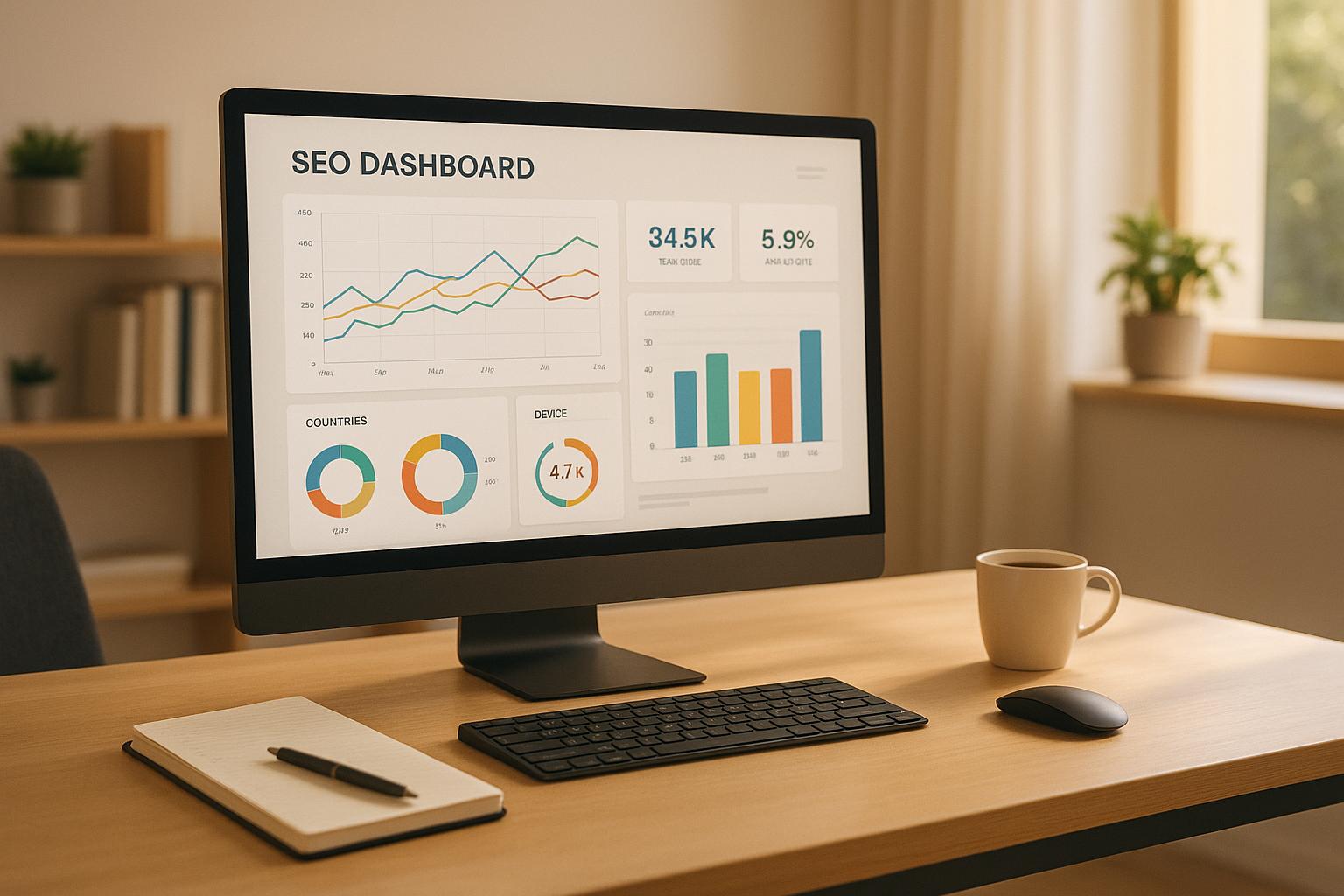Want to simplify SEO tracking? Custom SEO dashboard rules help you monitor key metrics, automate tasks, and connect SEO efforts to business goals. Here’s what you need to know:
- Track what matters: Set alerts for traffic drops, keyword rankings, and technical SEO issues.
- Automate workflows: Save time with automated notifications and task triggers.
- Align with goals: Focus on metrics tied to conversions, leads, or visibility.
- Improve efficiency: Reduce manual tracking by up to 70%.
Quick setup steps:
- Choose a dashboard tool that integrates with platforms like Google Analytics.
- Define clear performance goals (e.g., organic traffic, page speed).
- Configure rules with triggers, alerts, and workflows.
- Regularly review and refine rules for accuracy.
Custom rules make SEO monitoring faster, smarter, and more effective. Ready to take control of your SEO strategy? Let’s dive in.
How To Automate Your Own SEO Workflows w/ Andy O_neil
Benefits of Custom SEO Dashboard Rules
Custom SEO dashboard rules transform raw data into meaningful insights, making it easier to track progress and improve efficiency. These rules not only simplify monitoring but also enhance business performance and streamline team efforts.
Data Monitoring Improvements
Custom rules refine how metrics are tracked by zeroing in on the most important performance indicators.
Here’s how they improve monitoring:
- Real-time tracking: Keep tabs on rankings, traffic, and conversions as they happen.
- Performance targets: Set and monitor specific KPI thresholds for better focus.
- Cross-channel visibility: Bring together data from multiple platforms in one place.
- Anomaly detection: Spot unusual trends or issues quickly and take action.
SEO Task Automation
By automating repetitive tasks, custom rules save time and ensure consistency. This frees up teams to concentrate on more strategic initiatives.
Automation benefits include:
- Alerts and reporting: Get instant notifications and scheduled reports when key metrics hit or miss thresholds.
- Workflow triggers: Automatically initiate actions based on specific data trends.
- Resource optimization: Shift resources from time-consuming manual checks to higher-value strategic planning.
Business Goal Integration
Custom dashboard rules are most impactful when they align directly with a company’s goals, ensuring that SEO efforts drive measurable success.
"We craft tailored SEO plans based on your business’s unique needs. From day one, we focus on what matters most to you – whether it’s increasing leads, boosting conversions, or improving rankings." – SearchX | SEO Agency
| Business Goal | Rule Focus | Metrics |
|---|---|---|
| Lead Generation | Form submissions, contact requests | Conversion rate, lead quality score |
| E-commerce Sales | Product page performance, cart completions | Revenue, average order value |
| Brand Visibility | SERP rankings, featured snippets | Share of voice, brand mention tracking |
| Local Presence | Local pack rankings, GMB interactions | Local search visibility, direction requests |
This goal alignment delivers several advantages:
- Connects metrics to objectives: Every tracked metric ties back to a specific business goal.
- Tracks ROI: Measure the returns on your SEO investments with clear performance indicators.
- Informs strategic decisions: Use goal-specific metrics to guide decision-making.
- Streamlines reporting: Show the direct impact of SEO efforts on business outcomes.
Building dashboards that align metrics with business goals is a key step, and this concept will be explored further in the setup guide. These benefits create the foundation for effectively using custom SEO dashboard rules. Up next, we’ll break down how to set up these rules to achieve these results.
Custom SEO Dashboard Rules Setup Guide
Set up custom SEO dashboard rules with these steps to achieve measurable and actionable results.
Choosing the Right Dashboard Tool
Pick a dashboard tool that integrates seamlessly with key platforms and meets your specific needs. Here are some factors to consider:
| Selection Criteria | Description | Why It Matters |
|---|---|---|
| Data Integration | Connects effortlessly with tools like Google Analytics and Search Console | Ensures you can monitor all essential metrics in one place |
| Customization | Allows you to create tailored rules and dashboards | Helps address unique business requirements |
| Scalability | Grows with your business and data needs | Prepares you for future expansion |
| User Interface | Easy-to-use controls and navigation | Cuts down on training time and simplifies usage |
Look for platforms that offer strong API connections and pre-built integrations with critical data sources. Once you’ve chosen your tool, set clear performance goals that align with its capabilities.
Defining Performance Goals
Establish measurable targets that reflect your SEO priorities. For example:
- Primary Metrics: Focus on key outcomes like organic traffic, keyword rankings, and click-through rates.
- Supporting Indicators: Track additional factors such as page load speed, Core Web Vitals compliance, and crawl budget usage.
These metrics ensure your dashboard stays aligned with both your SEO strategy and broader business goals.
Steps to Configure Rules
Follow these steps to create and fine-tune your dashboard rules:
- Define Trigger Conditions: Set specific triggers, such as:
- Alerts for a drop in organic traffic exceeding 20% week-over-week.
- Notifications for keyword rankings falling below a set threshold.
- Monitoring Core Web Vitals that don’t meet benchmarks.
- Establish Action Workflows: Create automated responses like email notifications or task assignments to streamline follow-ups.
- Test and Validate: Run tests to ensure accuracy and avoid false positives. Adjust thresholds based on observed data trends to refine your setup.
Advanced SEO Dashboard Rules
Taking your custom SEO dashboard to the next level involves adding advanced rules that sharpen your monitoring with detailed analysis and well-timed actions.
Trend Analysis Tools
Leverage tools that provide historical data visualization and statistical modeling to analyze trends effectively. Here’s how different analysis types can help:
| Analysis Type | Purpose | Implementation |
|---|---|---|
| Pattern Recognition | Spot recurring SEO trends | Track weekly and monthly performance cycles |
| Anomaly Detection | Identify unusual metric shifts | Use multi-metric triggers for traffic and engagement |
| Predictive Modeling | Forecast future performance | Analyze historical data to estimate growth |
For instance, tracking both organic traffic and user engagement can help you understand how these factors influence each other. Effective trend analysis depends on integrating data from multiple sources, which we’ll address in the next section.
Data Source Connection
To ensure accurate and comprehensive SEO monitoring, connect and validate your data sources:
- Primary Data Sources
Link essential platforms like Google Analytics and Search Console with admin-level access to gather core metrics. - Secondary Platforms
Add additional data streams such as crawl data, backlink metrics, and ranking reports to enable more complex monitoring rules. - Data Validation
Cross-check data between sources to ensure accuracy, and set up alerts to flag any major inconsistencies.
With all your data centralized and validated, you’re ready to implement automated, time-sensitive monitoring.
Time-Based Rule Setup
Time-based rules are key to automating routine checks and staying ahead in SEO management. Configure your dashboard to:
- Run weekly checks for content older than six months to identify potential updates.
- Schedule monthly technical SEO audits, concentrating on Core Web Vitals.
- Set quarterly alerts for in-depth reviews of your backlink profile.
To avoid overwhelming your team with unnecessary notifications, focus on meaningful metrics. For example, create a rule that notifies you if a page’s organic traffic drops by 20% over 30 days while bounce rates rise. This could signal content quality issues that need immediate attention. Regularly review and refine these rules to keep them effective and relevant.
sbb-itb-880d5b6
Rule Management Guidelines
Managing advanced SEO dashboard rules effectively requires ongoing attention and a clear process. By using real-time dashboards, structured review schedules, timely alerts, and team collaboration, you can ensure your custom SEO dashboard rules stay relevant and aligned with your goals.
Rule Review Schedule
To keep your rules effective and up-to-date, follow a regular review process:
- Monthly audits: Check existing rules to ensure they remain relevant.
- Quarterly reviews: Evaluate rule performance in detail to identify areas for improvement.
- Bi-annual assessments: Reassess thresholds and triggers to match evolving priorities.
- Documentation: Record all changes to rules and their impact on monitoring efficiency.
Alert Management
Alerts are critical for staying on top of your SEO campaigns, but they need to be well-organized to avoid overwhelm. Here’s how to manage them effectively:
- Prioritize alerts: Assign levels like critical, important, or informational to focus on what matters most.
- Clear escalation paths: Define who handles each type of alert and how.
- Adjust frequency: Avoid notification overload by setting appropriate alert intervals.
- Response protocols: Develop specific actions for different alert scenarios.
- History log: Keep a record of alerts to analyze patterns and improve responses.
Team Input Process
Your team plays a vital role in refining SEO dashboard rules. Encourage their involvement with these steps:
- Feedback system: Set up a structured way for team members to share insights on rule effectiveness.
- Monthly meetings: Regularly discuss rule performance and gather input.
- Centralized platform: Use a shared space for submitting and reviewing suggestions.
- Validation process: Ensure new rule proposals are tested and approved before implementation.
- Impact tracking: Measure the results of team-suggested changes to understand their effectiveness.
Conclusion
Custom SEO dashboard rules play a crucial role in streamlining optimization efforts. By setting up automated monitoring systems with tailored alerts and performance tracking, teams can address SEO challenges more efficiently and respond faster to critical issues. These rules fit seamlessly into a broader SEO strategy, enhancing overall effectiveness.
Organizations that adopt custom rules often see more precise performance tracking and better alignment between SEO efforts and business goals. Key advantages include:
- Faster issue resolution through automated, threshold-based alerts
- Greater strategic focus by automating routine tasks
- Better decision-making with real-time performance insights
The success of these dashboards depends on proper setup and ongoing maintenance. Regular updates and refinements ensure they stay relevant and effective, keeping your SEO efforts proactive and impactful.
To illustrate the measurable benefits of custom dashboard rules, consider the following:
| Dashboard Impact Area | Measurable Benefit |
|---|---|
| Response Time | Immediate detection and resolution of issues |
| Team Efficiency | 60-70% reduction in manual monitoring tasks |
| Data Accuracy | Near real-time tracking of performance |
| Business Alignment | Clear connection between SEO metrics and business goals |
The evolution of SEO dashboards is steering toward integrating multiple data sources and leveraging AI-driven automation. By focusing on the right metrics and presenting data in an easy-to-understand way, organizations can create dashboards that deliver meaningful results and drive success in organic search.
FAQs
How do custom rules for SEO dashboards help streamline my team’s workflow?
Custom Rules for SEO Dashboards
Custom rules in SEO dashboards are a game-changer for streamlining your team’s workflow. They help automate repetitive tasks, keep key metrics front and center, and deliver real-time alerts when critical changes occur. By aligning these rules with your specific objectives, your team can shift their focus to more impactful work instead of spending time on manual checks.
For instance, you can create rules to flag sudden keyword ranking drops, spotlight pages experiencing declining traffic, or alert you to technical SEO issues. This way, your team can act swiftly and effectively, boosting both productivity and smarter decision-making.
What are the best practices for setting performance goals when creating custom rules for SEO dashboards?
When setting performance goals for custom SEO dashboard rules, focus on objectives that are measurable, actionable, and realistic, ensuring they align with your overall business strategy. Begin by identifying key metrics that matter most to your goals, such as organic traffic, conversion rates, or keyword rankings.
Leverage historical data to establish benchmarks and craft SMART goals – those that are Specific, Measurable, Achievable, Relevant, and Time-bound. For instance, you could set a target to boost organic traffic by 15% within the next quarter or improve the ranking of specific keywords within 60 days. Keep a close eye on performance, and don’t hesitate to adjust your rules to reflect shifting priorities or market changes.
How can I make sure my custom SEO dashboard alerts are useful without being overwhelming?
To make your SEO dashboard alerts both useful and manageable, focus on what matters most. Pinpoint the key metrics and triggers that align directly with your objectives – think major traffic drops, shifts in rankings, or pressing technical issues. Skip the alerts for minor changes that won’t significantly impact your strategy.
Set custom thresholds to minimize unnecessary noise, ensuring you’re only notified when metrics hit truly important levels. Group similar alerts together to cut down on redundancy and keep notifications clear and to the point. It’s also a good idea to revisit your alert settings regularly to keep them fine-tuned for your evolving needs.




